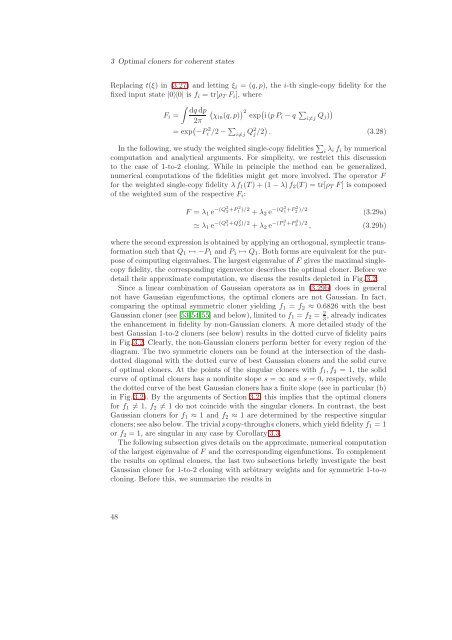Quantum Information Theory with Gaussian Systems
Quantum Information Theory with Gaussian Systems
Quantum Information Theory with Gaussian Systems
You also want an ePaper? Increase the reach of your titles
YUMPU automatically turns print PDFs into web optimized ePapers that Google loves.
3 Optimal cloners for coherent states<br />
Replacing t(ξ) in (3.27) and letting ξi = (q, p), the i-th single-copy fidelity for the<br />
fixed input state |0〉〈0| is fi = tr[ρT Fi], where<br />
<br />
dq dp <br />
Fi = χin(q, p)<br />
2π<br />
2 <br />
exp i (p Pi − q <br />
i=j Qj)<br />
= exp −P 2<br />
i /2 − <br />
i=j Q2 j /2 . (3.28)<br />
In the following, we study the weighted single-copy fidelities <br />
i λi fi by numerical<br />
computation and analytical arguments. For simplicity, we restrict this discussion<br />
to the case of 1-to-2 cloning. While in principle the method can be generalized,<br />
numerical computations of the fidelities might get more involved. The operator F<br />
for the weighted single-copy fidelity λf1(T) + (1 − λ)f2(T) = tr[ρT F] is composed<br />
of the weighted sum of the respective Fi:<br />
F = λ1 e −(Q2<br />
2 +P2<br />
1 )/2 + λ2 e −(Q2<br />
1 +P2<br />
2 )/2<br />
(3.29a)<br />
≃ λ1 e −(Q2<br />
1 +Q2<br />
2 )/2 + λ2 e −(P2<br />
1 +P2<br />
2 )/2 , (3.29b)<br />
where the second expression is obtained by applying an orthogonal, symplectic transformation<br />
such that Q1 ↦→ −P1 and P1 ↦→ Q1. Both forms are equivalent for the purpose<br />
of computing eigenvalues. The largest eigenvalue of F gives the maximal singlecopy<br />
fidelity, the corresponding eigenvector describes the optimal cloner. Before we<br />
detail their approximate computation, we discuss the results depicted in Fig. 3.2.<br />
Since a linear combination of <strong>Gaussian</strong> operators as in (3.29b) does in general<br />
not have <strong>Gaussian</strong> eigenfunctions, the optimal cloners are not <strong>Gaussian</strong>. In fact,<br />
comparing the optimal symmetric cloner yielding f1 = f2 ≈ 0.6826 <strong>with</strong> the best<br />
<strong>Gaussian</strong> cloner (see [53,54,55] and below), limited to f1 = f2 = 2<br />
3 , already indicates<br />
the enhancement in fidelity by non-<strong>Gaussian</strong> cloners. A more detailed study of the<br />
best <strong>Gaussian</strong> 1-to-2 cloners (see below) results in the dotted curve of fidelity pairs<br />
in Fig. 3.2. Clearly, the non-<strong>Gaussian</strong> cloners perform better for every region of the<br />
diagram. The two symmetric cloners can be found at the intersection of the dashdotted<br />
diagonal <strong>with</strong> the dotted curve of best <strong>Gaussian</strong> cloners and the solid curve<br />
of optimal cloners. At the points of the singular cloners <strong>with</strong> f1, f2 = 1, the solid<br />
curve of optimal cloners has a nonfinite slope s = ∞ and s = 0, respectively, while<br />
the dotted curve of the best <strong>Gaussian</strong> cloners has a finite slope (see in particular (b)<br />
in Fig. 3.2). By the arguments of Section 3.2, this implies that the optimal cloners<br />
for f1 = 1, f2 = 1 do not coincide <strong>with</strong> the singular cloners. In contrast, the best<br />
<strong>Gaussian</strong> cloners for f1 ≈ 1 and f2 ≈ 1 are determined by the respective singular<br />
cloners; see also below. The trivialcopy-throughcloners, which yield fidelity f1 = 1<br />
or f2 = 1, are singular in any case by Corollary 3.3.<br />
The following subsection gives details on the approximate, numerical computation<br />
of the largest eigenvalue of F and the corresponding eigenfunctions. To complement<br />
the results on optimal cloners, the last two subsections briefly investigate the best<br />
<strong>Gaussian</strong> cloner for 1-to-2 cloning <strong>with</strong> arbitrary weights and for symmetric 1-to-n<br />
cloning. Before this, we summarize the results in<br />
48
















